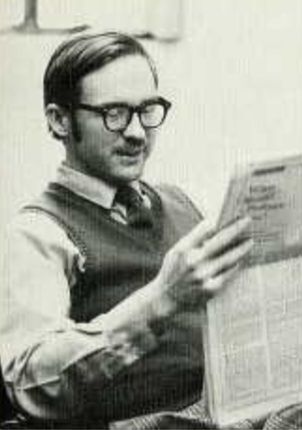He designed many crossword puzzles and word games starting in the 1970s and his most famous puzzle was the "Election Day" New York Times crossword puzzle that had two possible solutions: 'Bob Dole elected' and 'Clinton elected'. He helped organize the biennial Gathering for Martin Gardner conferences in 1993 and attended thereafter. From 2006 to 2017 he and his wife edited and published Word Ways: the Journal of Recreational Linguistics which was established in 1968 and is archived at Butler University. He was a member of MENSA, Dictionary Society of North America, Lewis Carroll Society, Mathematical Association of America, International Puzzle Party, Gathering for Gardner, National Puzzlers' League, and International Brotherhood of Magicians.
Jerry is survived by his wife, step-daughter, and step-son.
-----------------------------------
Jeremiah (Jerry) Farrell (December 12, 1937, in Hastings, Nebraska—July 4, 2022, in Indianapolis, Indiana)[1] was an American professor emeritus of mathematics at Butler University in Indiana. He was well known for having constructed Will Shortz's favorite puzzle, the 1996 "Election Day" crossword in The New York Times. He also wrote puzzles for many other books and newspapers, such as Scott Kim's puzzle column for Discover magazine.
Biography
Farrell was born in Hastings, Nebraska, the oldest of three children to Belle Einsphar and Paul Farrell, a third-generation railroad man. Farrell himself worked for one summer on the railroad, as a "grinder", one who planes down the railroad tracks so they stay smooth. He attended Hastings High School, graduating in 1955, and then the University of Nebraska, graduating in 1963 with degrees in mathematics, chemistry, and physics. He later obtained a master's degree in mathematics, and in 1966 was hired by Butler University, where he worked for the next 40 years, teaching nearly every subject in the mathematics department. He officially retired in 1994, but continued to teach.
He was best known for constructing many crossword puzzles for The New York Times, starting in the 1970s for editor Margaret Farrar, and then continuing to design new puzzles after Shortz took over. In 1996, he designed his most famous puzzle, the "Election Day" crossword. One of the words had the clue "lead story tomorrow", with a 14-letter answer. The puzzle had two correct solutions: "Bob Dole elected" and "Clinton elected", and all the crossing words were designed such that they could be one of two different words, to make either answer work. Shortz called it an "amazing" feat and his favorite puzzle.
With his wife Karen, Farrell helped organize the biannual Gathering for Gardner conferences, which started in 1993 as an invitation-only event for people connected with Martin Gardner.
In 2006 Farrell and his wife took over from A. Ross Eckler, Jr. as editors and publishers of the quarterly publication Word Ways: the Journal of Recreational Linguistics, established in 1968.
Contributed works
Zen and the Art of Magic Squares
A.K. Peters publications (where he is called a "mathemagician")
Discover magazine
Contributor: Kbed (48698440)
He designed many crossword puzzles and word games starting in the 1970s and his most famous puzzle was the "Election Day" New York Times crossword puzzle that had two possible solutions: 'Bob Dole elected' and 'Clinton elected'. He helped organize the biennial Gathering for Martin Gardner conferences in 1993 and attended thereafter. From 2006 to 2017 he and his wife edited and published Word Ways: the Journal of Recreational Linguistics which was established in 1968 and is archived at Butler University. He was a member of MENSA, Dictionary Society of North America, Lewis Carroll Society, Mathematical Association of America, International Puzzle Party, Gathering for Gardner, National Puzzlers' League, and International Brotherhood of Magicians.
Jerry is survived by his wife, step-daughter, and step-son.
-----------------------------------
Jeremiah (Jerry) Farrell (December 12, 1937, in Hastings, Nebraska—July 4, 2022, in Indianapolis, Indiana)[1] was an American professor emeritus of mathematics at Butler University in Indiana. He was well known for having constructed Will Shortz's favorite puzzle, the 1996 "Election Day" crossword in The New York Times. He also wrote puzzles for many other books and newspapers, such as Scott Kim's puzzle column for Discover magazine.
Biography
Farrell was born in Hastings, Nebraska, the oldest of three children to Belle Einsphar and Paul Farrell, a third-generation railroad man. Farrell himself worked for one summer on the railroad, as a "grinder", one who planes down the railroad tracks so they stay smooth. He attended Hastings High School, graduating in 1955, and then the University of Nebraska, graduating in 1963 with degrees in mathematics, chemistry, and physics. He later obtained a master's degree in mathematics, and in 1966 was hired by Butler University, where he worked for the next 40 years, teaching nearly every subject in the mathematics department. He officially retired in 1994, but continued to teach.
He was best known for constructing many crossword puzzles for The New York Times, starting in the 1970s for editor Margaret Farrar, and then continuing to design new puzzles after Shortz took over. In 1996, he designed his most famous puzzle, the "Election Day" crossword. One of the words had the clue "lead story tomorrow", with a 14-letter answer. The puzzle had two correct solutions: "Bob Dole elected" and "Clinton elected", and all the crossing words were designed such that they could be one of two different words, to make either answer work. Shortz called it an "amazing" feat and his favorite puzzle.
With his wife Karen, Farrell helped organize the biannual Gathering for Gardner conferences, which started in 1993 as an invitation-only event for people connected with Martin Gardner.
In 2006 Farrell and his wife took over from A. Ross Eckler, Jr. as editors and publishers of the quarterly publication Word Ways: the Journal of Recreational Linguistics, established in 1968.
Contributed works
Zen and the Art of Magic Squares
A.K. Peters publications (where he is called a "mathemagician")
Discover magazine
Contributor: Kbed (48698440)
Family Members
Sponsored by Ancestry
Advertisement
Advertisement






